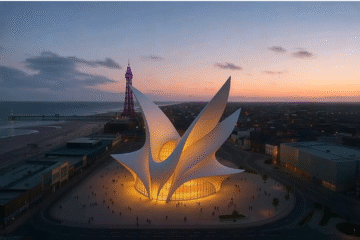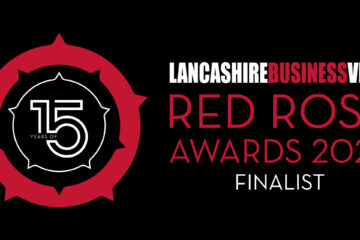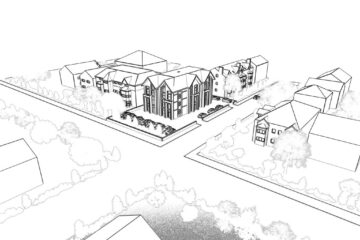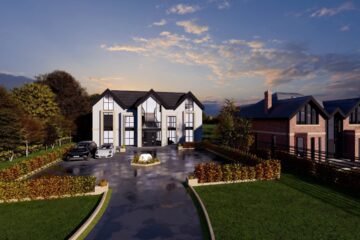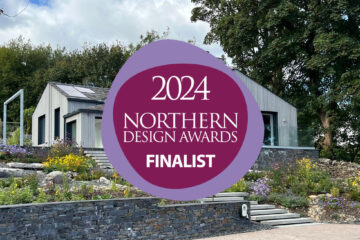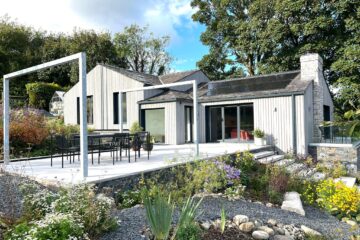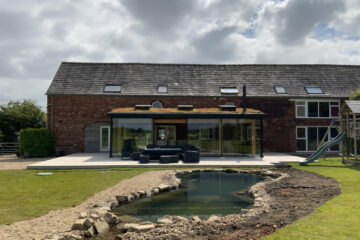Green Belt Development, Extending houses or replacing a property in the Green Belt is covered by some specific legislation and The National Policy Framework (NPPF).
The government attaches great importance to Green Belts and the fundamental aim of the policy is to prevent urban sprawl by keeping land permanently open. The essential characteristics of green belts are their openness and their permanence.
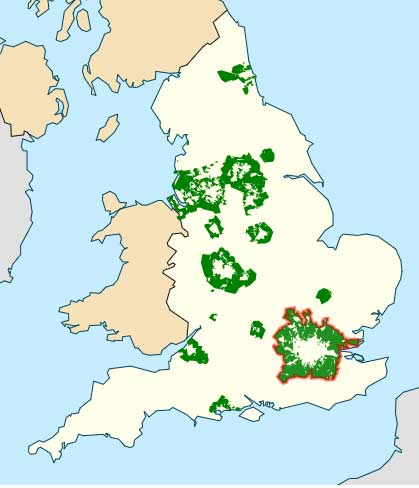
Metropolitan Green Belt among the green belts of England.
Image by Wikimedia
To begin to realise the opportunities it’s necessary to first understand that the five purposes of the Green Belt are to:
- prevent adjacent towns merging into one another;
- preserve the special characteristics and settings of historic towns;
- stop the sprawl of large built-up areas;
- help urban regeneration by encouraging the recycling of derelict and other urban land and;
- protect the countryside from urban encroachment.
A specific paragraph in the legislation (87) begins to provide a glimmer of hope:
“As with previous Green Belt policy, inappropriate development is, by definition, harmful to the Green Belt and should not be approved except in very special circumstances. New buildings are inappropriate unless they fall within a limited number of exceptions.”
Understanding The Legislation
The extension or alteration of a building is allowable, provided that it does not result in disproportionate additions over and above the size of the original building. From a planning point of view, the keywords are in italics - allowable and disproportionate.
Different local planning authorities (LPAs) may have different interpretations of ‘disproportionate’ so their specific local policies require investigation. As a typical guide, a 30% increase in floor space is not uncommon. Some LPAs may make external footprint or volume the starting point before considering the internal floorspace of a scheme.
For example, the West Lancashire Borough Council considers any extension or alteration to a building within the Green Belt that exceeds 40% of the volume of the original building to be materially larger and therefore disproportionate.
This figure of 40% is provided as a guide only. There may be cases where an extension of less than this volume would be considered to have an unacceptable impact upon the perceived openness of the Green Belt in certain locations.
Figure 1 and 2 illustrate examples of extensions of less than 40% of the size of the original property which, due to their form and projection from the original building, may be judged to have a greater perception of negative impact upon openness.
Figure 3 on the other hand, illustrates an extension of 40% of the original property. Due to its position in relation to the property, the impact of this form of extension upon the perceived openness of the Green Belt would be substantially less than the extensions in Figures 1 or 2. Similarly, it may be possible to have an extension, similar to that shown in Figure 3, but of marginally more than 40% of the original property, whose impact upon the perceived openness of the Green Belt is also substantially less than the extensions in Figures 1 or 2.
In summary, the prominent or easily visible expansion of a building will detract more from the perceived openness of the Green Belt than would a more concealed or compact form of expansion. For example, the infilling of space between existing parts of the building, so that no further outward projection is involved, would often have no material effect on the perceived openness of the Green Belt.
The originality of a building is defined as how the building stood before the introduction of the Planning Act on 1 July 1948. Any later extensions (whether following planning approval or permitted development) may not be included. It’s important to fully understand the history or your property, in some cases houses have already been extended past the allowable figure. This could mean that planning officers wouldn’t accept any further house extensions within the green belt or open countryside.
Self-build And New Build
An amazing new piece of architecture in the beautiful countryside is obviously very appealing.
Example of a planning application that was approved for appropriate residential development in the Green Belt:
The National Planning Policy Framework ( NPFF ) states five main options if this is your objective:
- limited infilling in villages, and limited affordable housing for local community needs under policies set out in the Local Plan;
- limited infilling or the partial or complete redevelopment of previously developed sites (brownfield land), whether redundant or in continuing use (excluding temporary buildings), which would not have a greater impact on the openness of the Green Belt and the purpose of including land within it than the existing development;
- the replacement of a building, provided the new building is in the same use and not materially larger than the one it replaces and;
- creating bespoke homes that meet the exceptional quality or innovative in nature requirements of Paragraph 79 of the NPPF to satisfy the “very special circumstances” caveat. Please see our dedicated webpage on this.
In addition, there may be possibilities for:
The infilling of sites or redevelopment of brownfield sites in green belt or open countryside are very site-specific. A detailed review and analysis would be required to ascertain the issues, possibilities and opportunities.
When replacing a dwelling, planners typically start by looking at the existing rather than the original home in determining whether a scheme is ‘materially larger. There is potentially more scope compared to extending within the Green Belt but external footprint, volume, scale and massing, the character of the area etc. will still be considered.
Different LPAs will have different approaches and policies so understanding the local landscape is crucial. As a rule of thumb, an increase greater than 15% on the existing building is seen as being materially larger. Double height spaces, basements, permitted development, outbuildings, garden rooms etc. can add further complications.
» The conversion of existing buildings in the open countryside; for more information please see Barn Conversions.
Carter’s Experience Of Green Belt Projects
Carter’s operates in many green belt areas so have experience of many physical and political landscapes. Our portfolio of clients has realised many exciting solutions to the challenges faced.
Flexibility, time and research have been the keys to success. Research the area and the local legislation; take the time to work with us and start the conversation with your Local Planning Authority earlier rather than later; and be flexible to new approaches in design, scale, character and materials etc. in order to satisfy the needs of all stakeholders.
Alderley Edge Green Belt Homes
New residential positive energy homes in Alderley Edge in green belt
Poulton-le-Fylde, Passive House Standard, Green Belt Development
Poulton-le-Fylde, Carbon Natural, Green Belt Development
Cheshire , Carbon Natural, Green Belt Development
If you have a parcel of land or want to extend your home that’s in green belt, feel free to get in touch for a free consultation.



























